Lookup Tables for Power Generation Performance of Photovoltaic Systems Covering 40 Geographic Locations (Wilayats) in the Sultanate of Oman, with and without Solar Tracking, and General Perspectives about Solar Irradiation
Abstract
:1. Introduction
- Fixed PV panels with optimum azimuth and tilt;
- Moving PV panels with vertical-axis solar tracking;
- Moving panels with two-axis solar tracking.
2. Methods
3. Results
3.1. Validation against Third-Party Calculated Results
3.2. PV Design Type 1: Fixed Optimized Orientation
3.3. PV Design Type 2: Single-Vertical-Axis Solar Tracking
3.4. PV Design Type 3: Two-Axis Solar Tracking
3.5. Some Monthly Profiles of PV Electricity
3.6. General Perspectives and Remarks about Contributions
4. Discussion
- For fixed optimized orientation: 1.0316 ÷ 0.92345 = 1.117 (or 11.17% increase);
- For single-vertical-axis tracking: 1.0716 ÷ 0.91358 = 1.173 (or 11.73% increase);
- For two-axis tracking: 1.0800 ÷ 0.91032 = 1.186 (or 11.86% increase).
5. Conclusions
Funding
Institutional Review Board Statement
Informed Consent Statement
Data Availability Statement
Acknowledgments
Conflicts of Interest
Appendix A
| Name of Selected Wilayat | Latitude (Degrees, Arcminutes, Arcseconds) | Longitude (Degrees, Arcminutes, Arcseconds) | Elevation (m) |
|---|---|---|---|
| Muscat | N 23°35′2″ | E 58°24′28″ | 17 |
| Qurayyat | N 23°15′46″ | E 58°55′12″ | 7 |
| A’Seeb | N 23°40′13″ | E 58°11′20″ | 6 |
| Sohar | N 24°20′50″ | E 56°42′33″ | 11 |
| Al Suwaiq | N 23°50′58″ | E 57°26′19″ | 6 |
| Shinas | N 24°44′33″ | E 56°28′1″ | 2 |
| Nizwa | N 22°56′0″ | E 57°32′0″ | 507 |
| Adam | N 22°22′45″ | E 57°31′37″ | 284 |
| Samail | N 23°17′54″ | E 57°57′11″ | 402 |
| Al Hamra | N 23°6′54″ | E 57°17′29″ | 649 |
| Al Rustaq | N 23°23′27″ | E 57°25′28′ | 344 |
| Barka | N 23°40′43″ | E 57°53′9″ | 13 |
| Wadi Al Ma’awil | N 23°27′51″ | E 57°49′18″ | 212 |
| Salalah | N 17°0′54″ | E 54°5′32″ | 16 |
| Muqshin | N 19°29′53″ | E 54°50′36″ | 113 |
| Shalim and the Hallaniyat Islands | N 18°6′9″ | E 55°39′12″ | 269 |
| Dhalkut | N 16°42′14″ | E 53°14′31″ | 9 |
| Al Mazyona | N 17°50′18″ | E 52°39′37″ | 504 |
| Thumrait | N 17°40′12″ | E 54°2′0″ | 454 |
| Sadah | N 17°3′0″ | E 55°4′0″ | 44 |
| Sur | N 22°34′0″ | E 59°31′44″ | 7 |
| Masirah | N 20°39′2″ | E 58°52′22″ | 12 |
| Jaalan Bani Bu Ali | N 22°0′56″ | E 59°20′1″ | 92 |
| Ibra | N 22°41′26″ | E 58°32′0″ | 436 |
| Al Mudhaibi | N 22°34′13″ | E 58°7′16″ | 401 |
| Wadi Bani Khalid | N 22°34′48″ | E 59°5′35″ | 600 |
| Bidiya | N 22°26′25″ | E 58°47′57″ | 290 |
| Ibri | N 23°13′32″ | E 56°30′56″ | 361 |
| Yankul | N 23°35′11″ | E 56°32′22″ | 546 |
| Dhank | N 23°33′1″ | E 56°15′26″ | 342 |
| Al Buraimi | N 24°15′3″ | E 55°47′35″ | 298 |
| Al Sunaynah | N 23°36′23″ | E 55°57′16″ | 255 |
| Mahdah | N 24°24′1″ | E 55°58′1″ | 426 |
| Haima | N 19°57′33″ | E 56°16′32″ | 135 |
| Duqm | N 19°39′43″ | E 57°42′13″ | 4 |
| Al Jazer | N 18°32′42″ | E 56°21′36″ | 144 |
| Mahout | N 20°42′0″ | E 57°55′19″ | 40 |
| Khasab | N 26°10′47″ | E 56°14′51″ | 11 |
| Dibba | N 25°38′11″ | E 56°15′57″ | 1 |
| Madha | N 25°16′53″ | E 56°18′57″ | 97 |
| Location | Country | Latitude (Degrees, Arcminutes, Arcseconds) | Longitude (Degrees, Arcminutes, Arcseconds) | Elevation (m) |
|---|---|---|---|---|
| Al Jawf | Libya | N 24°11′56″ | E 23°17′27″ | 391 |
| Riyadh | Saudi Arabia | N 24°41′15″ | E 46°43′18″ | 612 |
| Muscat | Oman | N 23°35′2″ | E 58°24′28″ | 17 |
| Gaborone | Botswana | S 24°39′16″ | E 25°54′30″ | 1013 |
| Karachi | Pakistan | N 24°51′38″ | E 67°0′37″ | 10 |
| Carnarvon Airport | Australia | S 24°52′50″ | E 113°40′19″ | 5 |
| Ahmedabad | India | N 23°1′32″ | E 72°35′14″ | 55 |
| Havana | Cuba | N 23°7′58″ | W 82°22′58″ | 37 |
| Culiacán | Mexico | N 24°47′25″ | W 107°23′16″ | 92 |
| São Paulo | Brazil | S 23°32′51′ | W 46°38′10″ | 784 |
| Dhaka | Bangladesh | N 23°42′37″ | E 90°24′26″ | 17 |
| Baise | China | N 23°53′59″ | E 106°36′48″ | 134 |
Appendix B
| Name of Selected Wilayat | Optimized Slope (°) | Optimized Azimuth, from South (°) | Yearly Global Solar Irradiation Received by m2 of Tilted PV Panels Surface (kWh/m2/year) | Translation Factor (X to Muscat) for Yearly PV Electricity Production |
|---|---|---|---|---|
| Muscat | 25 | 0 | 2500.82 | 1.0000 |
| Qurayyat | 25 | 0 | 2489.68 | 0.99495 |
| A’Seeb | 25 | 0 | 2502.94 | 0.99855 |
| Sohar | 25 | 0 | 2509.63 | 0.99392 |
| Al Suwaiq | 25 | 0 | 2515.81 | 0.98945 |
| Shinas | 25 | 1 | 2493.46 | 0.98423 |
| Nizwa | 25 | −4 | 2516.22 | 0.99362 |
| Adam | 25 | −3 | 2575.14 | 0.96714 |
| Samail | 25 | −7 | 2492.28 | 1.0004 |
| Al Hamra | 25 | −7 | 2507.2 | 0.99871 |
| Al Rustaq | 26 | 0 | 2469.7 | 1.0116 |
| Barka | 25 | 0 | 2506.1 | 0.99854 |
| Wadi Al Ma’awil | 25 | −2 | 2496.78 | 1.0040 |
| Salalah | 21 | 5 | 2383.35 | 0.99728 |
| Muqshin | 22 | −1 | 2583.42 | 0.95280 |
| Shalim and the Hallaniyat Islands | 20 | 0 | 2562.06 | 0.94005 |
| Dhalkut | 22 | 0 | 2328.4 | 1.0246 |
| Al Mazyona | 20 | −4 | 2610.95 | 0.94111 |
| Thumrait | 20 | 0 | 2618.37 | 0.92345 |
| Sadah | 20 | 2 | 2440.66 | 0.96510 |
| Sur | 24 | 0 | 2523.19 | 0.98118 |
| Masirah | 23 | 4 | 2514.08 | 0.94424 |
| Jaalan Bani Bu Ali | 24 | −1 | 2552.07 | 0.96129 |
| Ibra | 25 | −4 | 2522.88 | 0.98923 |
| Al Mudhaibi | 25 | −4 | 2535.23 | 0.98424 |
| Wadi Bani Khalid | 24 | −5 | 2505.25 | 0.98250 |
| Bidiya | 25 | −2 | 2564.14 | 0.96101 |
| Ibri | 25 | −5 | 2547.62 | 0.98085 |
| Yankul | 24 | −2 | 2487.99 | 1.0019 |
| Dhank | 25 | −5 | 2539.44 | 0.98800 |
| Al Buraimi | 25 | −4 | 2499.83 | 0.99104 |
| Al Sunaynah | 25 | −4 | 2542.3 | 0.97983 |
| Mahdah | 23 | −1 | 2582.44 | 0.94764 |
| Haima | 23 | −1 | 2582.44 | 0.94764 |
| Duqm | 21 | 1 | 2458.12 | 0.96761 |
| Al Jazer | 21 | 1 | 2582.31 | 0.93129 |
| Mahout | 23 | −1 | 2551.41 | 0.95471 |
| Khasab | 25 | 3 | 2410.21 | 1.0069 |
| Dibba | 26 | 0 | 2384.36 | 1.0294 |
| Madha | 24 | −11 | 2355.45 | 1.0316 |
| Name of Selected Wilayat | Optimized Slope (°) | Yearly Global Solar Radiation Received by m2 of Tilted PV Panels Surface (kWh/m2/year) | Translation Factor (X to Muscat) for Yearly PV Electricity Production |
|---|---|---|---|
| Muscat | 49 | 3209.54 | 1.0000 |
| Qurayyat | 49 | 3192.19 | 0.99431 |
| A’Seeb | 49 | 3216.3 | 0.99672 |
| Sohar | 49 | 3220.74 | 0.99354 |
| Al Suwaiq | 49 | 3232.53 | 0.98801 |
| Shinas | 49 | 3188.7 | 0.98879 |
| Nizwa | 48 | 3203.7 | 1.0040 |
| Adam | 49 | 3304.69 | 0.96816 |
| Samail | 48 | 3171.57 | 1.0105 |
| Al Hamra | 48 | 3191.02 | 1.0095 |
| Al Rustaq | 48 | 3136.45 | 1.0247 |
| Barka | 49 | 3221.28 | 0.99659 |
| Wadi Al Ma’awil | 49 | 3201.32 | 1.0062 |
| Salalah | 47 | 3032.6 | 1.0071 |
| Muqshin | 48 | 3315.31 | 0.95239 |
| Shalim and the Hallaniyat Islands | 47 | 3307.1 | 0.93211 |
| Dhalkut | 47 | 2945.66 | 1.0409 |
| Al Mazyona | 47 | 3373.23 | 0.93417 |
| Thumrait | 47 | 3390.48 | 0.91358 |
| Sadah | 46 | 3111.59 | 0.97085 |
| Sur | 48 | 3231.73 | 0.98079 |
| Masirah | 47 | 3201.48 | 0.95063 |
| Jaalan Bani Bu Ali | 48 | 3268.93 | 0.96041 |
| Ibra | 49 | 3229.52 | 0.99186 |
| Al Mudhaibi | 48 | 3248.05 | 0.98682 |
| Wadi Bani Khalid | 47 | 3160.65 | 1.0034 |
| Bidiya | 48 | 3282.28 | 0.96358 |
| Ibri | 49 | 3263.67 | 0.98308 |
| Yankul | 47 | 3136.6 | 1.0236 |
| Dhank | 49 | 3252.63 | 0.99104 |
| Al Buraimi | 49 | 3207.5 | 0.99030 |
| Al Sunaynah | 49 | 3263.15 | 0.97923 |
| Mahdah | 48 | 3304.5 | 0.95005 |
| Haima | 48 | 3304.5 | 0.95005 |
| Duqm | 47 | 3115.44 | 0.97770 |
| Al Jazer | 47 | 3319.9 | 0.92742 |
| Mahout | 48 | 3261.77 | 0.95623 |
| Khasab | 47 | 3007.45 | 1.0421 |
| Dibba | 49 | 3044.7 | 1.0339 |
| Madha | 46 | 2923.53 | 1.0716 |
| Name of Selected Wilayat | Yearly Global Solar Radiation Received by m2 of Tilted PV Panels Surface (kWh/m2/year) | Translation Factor (X to Muscat) for Yearly PV Electricity Production |
|---|---|---|
| Muscat | 3351.52 | 1.0000 |
| Qurayyat | 3334.6 | 0.99371 |
| A’Seeb | 3359.41 | 0.99634 |
| Sohar | 3362.95 | 0.99357 |
| Al Suwaiq | 3376.56 | 0.98769 |
| Shinas | 3326.57 | 0.98946 |
| Nizwa | 3342.55 | 1.0053 |
| Adam | 3452.65 | 0.96774 |
| Samail | 3307.15 | 1.0123 |
| Al Hamra | 3332.27 | 1.0097 |
| Al Rustaq | 3268.32 | 1.0273 |
| Barka | 3364.62 | 0.99632 |
| Wadi Al Ma’awil | 3342.71 | 1.0067 |
| Salalah | 3173.52 | 1.0037 |
| Muqshin | 3464.9 | 0.95139 |
| Shalim and the Hallaniyat Islands | 3461.08 | 0.92908 |
| Dhalkut | 3080.14 | 1.0385 |
| Al Mazyona | 3532.27 | 0.93145 |
| Thumrait | 3550.34 | 0.91032 |
| Sadah | 3254.42 | 0.96772 |
| Sur | 3375.57 | 0.98024 |
| Masirah | 3344.8 | 0.94891 |
| Jaalan Bani Bu Ali | 3415.83 | 0.95906 |
| Ibra | 3374.9 | 0.99139 |
| Al Mudhaibi | 3394.07 | 0.98633 |
| Wadi Bani Khalid | 3288.11 | 1.0074 |
| Bidiya | 3428.77 | 0.96304 |
| Ibri | 3409.06 | 0.98285 |
| Yankul | 3262.4 | 1.0280 |
| Dhank | 3396.47 | 0.99133 |
| Al Buraimi | 3348.81 | 0.99039 |
| Al Sunaynah | 3407.74 | 0.97915 |
| Mahdah | 3451.71 | 0.94934 |
| Haima | 3451.71 | 0.94934 |
| Duqm | 3254.41 | 0.97606 |
| Al Jazer | 3471.93 | 0.92503 |
| Mahout | 3407.27 | 0.95505 |
| Khasab | 3111.62 | 1.0517 |
| Dibba | 3174.02 | 1.0352 |
| Madha | 3027.54 | 1.0800 |
References
- Masson-Delmotte, V.; Zhai, P.; Pörtner, H.-O.; Roberts, D.; Skea, J.; Shukla, P.R.; Pirani, A.; Moufouma-Okia, W.; Péan, C.; Pidcock, R.; et al. (Eds.) IPCC, 2018: Summary for Policymakers. In Global Warming of 1.5 °C. An IPCC Special Report on the Impacts of Global Warming of 1.5 °C Above Pre-Industrial Levels and Related Global Greenhouse Gas Emission Pathways, in the Context of Strengthening the Global Response to the Threat of Climate Change, Sustainable Development, and Efforts to Eradicate Poverty; World Meteorological Organization: Geneva, Switzerland, 2018; p. 32. Available online: https://www.ipcc.ch/site/assets/uploads/sites/2/2019/05/SR15_SPM_version_stand_alone_HR.pdf (accessed on 18 September 2021).
- IRENA (International Renewable Energy Agency). World Energy Transitions Outlook: 1.5 °C Pathway; IRENA: Abu Dhabi, United Arab Emirates, 2021; p. 321. Available online: https://www.irena.org/publications/2021/Jun/-/media/C3BB1085FEA5401D9CA9598A61C8B267.ashx (accessed on 29 July 2021).
- Distribution of Renewable Energy Technologies by IRENA (International Renewable Energy Agency). Available online: https://www.irena.org/Statistics/View-Data-by-Topic/Capacity-and-Generation/Technologie (accessed on 25 September 2021).
- Remap—Renewable Energy Roadmaps by IRENA (International Renewable Energy Agency). Available online: https://www.irena.org/remap (accessed on 25 September 2021).
- Solar PV Power Generation in the Sustainable Development Scenario, 2000–2030. IEA (International Energy Agency), Paris. Available online: https://www.iea.org/data-and-statistics/charts/solar-pv-power-generation-in-the-sustainable-development-scenario-2000-2030 (accessed on 25 September 2021).
- Alboteanu, I.L.; Bulucea, C.A.; Degeratu, S. Estimating Solar Irradiation Absorbed by Photovoltaic Panels with Low Concentration Located in Craiova, Romania. Sustainability 2015, 7, 2644–2661. [Google Scholar] [CrossRef] [Green Version]
- Katiyar, A.K.; Pandey, C.K. A Review of Solar Radiation Models—Part I. J. Renew. Energy 2013, 2013, 11. [Google Scholar] [CrossRef] [Green Version]
- Bakirci, K. Models for Determination of Solar Energy Potential. Energy Explor. Exploit. 2008, 26, 281–292. [Google Scholar] [CrossRef]
- Xie, C.; Schimpf, C.; Chao, J.; Nourian, S.; Massicotte, J. Learning and teaching engineering design through modeling and simulation on a CAD platform. Comput. Appl. Eng. Educ. 2018, 26, 824–840. [Google Scholar] [CrossRef]
- Sharma, S.; Kurian, C.P.; Paragond, L.S. Solar PV System Design Using PVsyst: A Case Study of an Academic Institute. In Proceedings of the International Conference on Control, Power, Communication and Computing Technologies (ICCPCCT), Kannur, India, 23–24 March 2018; IEEE (Institute of Electrical and Electronics Engineers): New York City, NY, USA; pp. 123–128. [Google Scholar] [CrossRef]
- Sources of Meteo Data in Monthly Values—PVsyst. Available online: https://www.pvsyst.com/meteo-data-source (accessed on 25 September 2021).
- Honnurvali, M.S.; Gupta, N.; Goh, K.; Umar, T.; Kabbani, A.; Nazeema, N. Case study of PV output power degradation rates in Oman. IET Renew. Power Gener. 2019, 13, 352–360. [Google Scholar] [CrossRef] [Green Version]
- Al-Badi, A. Performance assessment of 20.4 kW eco-house grid-connected PV plant in Oman. Int. J. Sustain. Eng. 2020, 13, 230–241. [Google Scholar] [CrossRef]
- ESMAP (Energy Sector Management Assistance Program). Global Photovoltaic Power Potential by Country; World Bank: Washington, DC, USA, 2020; p. 62. Available online: https://documents1.worldbank.org/curated/en/466331592817725242/pdf/Global-Photovoltaic-Power-Potential-by-Country.pdf (accessed on 14 June 2021).
- IRENA (International Renewable Energy Agency). Renewables Readiness Assessment: Sultanate of Oman; International Renewable Energy Agency: Abu Dhabi, United Arab Emirates, 2014; p. 88. Available online: https://www.irena.org/-/media/Files/IRENA/Agency/Publication/2014/IRENA_RRA_Oman_2014_LR.pdf (accessed on 25 September 2021).
- DATA PORTAL, Labor Market, Data of Year 2018 by National Centre for Statistics & Information (NCSI) of the Sultanate of Oman. Available online: https://data.gov.om/nyavlmf/labor-market (accessed on 23 September 2021).
- DATA PORTAL, Communication, Data of Year 2018 by National Centre for Statistics & Information (NCSI) of the Sultanate of Oman. Available online: https://data.gov.om/lgtrktf/communication?indicator=No.%20of%20Exchanges (accessed on 23 September 2021).
- PVGIS Contact Points. Available online: https://ec.europa.eu/jrc/en/PVGIS/about/contact (accessed on 26 September 2021).
- PVGIS Users Manual. Available online: https://ec.europa.eu/jrc/en/PVGIS/docs/usermanual (accessed on 25 September 2021).
- CM SAF (Satellite Application Facility on Climate Monitoring). Available online: https://www.cmsaf.eu/EN/Home/home_node.html (accessed on 25 September 2021).
- PVGIS Data Sources and Calculation Methods. Available online: https://ec.europa.eu/jrc/en/PVGIS/docs/methods (accessed on 25 September 2021).
- Mueller, R.; Behrendt, T.; Hammer, A.; Kemper, A. A New Algorithm for the Satellite-Based Retrieval of Solar Surface Irradiance in Spectral Bands. Remote Sens. 2012, 4, 622–647. [Google Scholar] [CrossRef] [Green Version]
- Mueller, R.; Matsoukas, C.; Gratzki, A.; Behr, H.D.; Hollmann, R. The CM-SAF operational scheme for the satellite based retrieval of solar surface irradiance—A LUT based eigenvector hybrid approach. Remote Sens. Environ. 2009, 113, 1012–1024. [Google Scholar] [CrossRef]
- Huld, T.; Müller, R.; Gambardella, A. A new solar radiation database for estimating PV performance in Europe and Africa. Sol. Energy 2012, 86, 1803–1815. [Google Scholar] [CrossRef]
- Gracia Amillo, A.; Huld, T.; Müller, R. A New Database of Global and Direct Solar Radiation Using the Eastern Meteosat Satellite, Models and Validation. Remote Sens. 2014, 6, 8165–8189. [Google Scholar] [CrossRef] [Green Version]
- BSRN (Baseline Surface Radiation Network): Baseline Surface Radiation Network. Available online: https://bsrn.awi.de (accessed on 25 September 2021).
- DATA PORTAL, Population, Data of August 2021 by National Centre for Statistics & Information (NCSI) of the Sultanate of Oman. Available online: https://data.gov.om/amxduh/population (accessed on 23 September 2021).
- Oman by region—Foreign Ministry of Oman. Available online: https://fm.gov.om/about-oman/state/oman-by-region (accessed on 22 September 2021).
- About Oman—Omani Ministry of Health. Available online: https://www.moh.gov.om/en/about-oman (accessed on 21 September 2021).
- Map of the Sultanate of Oman—By the National Survey Authority, Ministry of Defense—Hosted at the Website of the Foreign Ministry of Oman. Available online: https://fm.gov.om/wp-content/uploads/Oman_Map_AR.pdf (accessed on 22 September 2021).
- Cotfas, D.T.; Cotfas, P.A. Comparative Study of Two Commercial Photovoltaic Panels under Natural Sunlight Conditions. Int. J. Photoenergy 2019, 2019, 10. [Google Scholar] [CrossRef] [Green Version]
- Andreani, L.C.; Bozzola, A.; Kowalczewski, P.; Liscidini, M.; Redorici, L. Silicon solar cells: Toward the efficiency limits. Adv. Phys. X 2019, 4, 24. [Google Scholar] [CrossRef] [Green Version]
- Common Types of Solar Cells—What Are Better Silicon, Monocrystalline, or Polycrystalline Solar Cells? Available online: https://www.altenergy.org/renewables/solar/common-types-of-solar-cells.html (accessed on 26 September 2021).
- Attari, K.; Elyaakoubi, A.; Asselman, A. Performance analysis and investigation of a grid-connected photovoltaic installation in Morocco. Energy Rep. 2016, 2, 261–266. [Google Scholar] [CrossRef] [Green Version]
- Global Solar Atlas (GSA), data for 23.583889°, 058.407778° (Muscat). Available online: https://globalsolaratlas.info/detail?s=23.583889,58.407778&m=site&c=23.583497,58.40744,11 (accessed on 25 September 2021).
- Darhmaoui, H.; Lahjouji, D. Latitude Based Model for Tilt Angle Optimization for Solar Collectors in the Mediterranean Region. Energy Procedia 2013, 42, 26–435. [Google Scholar] [CrossRef] [Green Version]
- Dhimish, M.; Silvestre, S. Estimating the impact of azimuth-angle variations on photovoltaic annual energy production. Clean Energy 2019, 3, 47–58. [Google Scholar] [CrossRef] [Green Version]
- Seme, S.; Štumberger, B.; Hadžiselimović, M.; Sredenšek, K. Solar Photovoltaic Tracking Systems for Electricity Generation: A Review. Energies 2020, 13, 4224. [Google Scholar] [CrossRef]
- Hereher, M.; El Kenawy, A.M. Exploring the potential of solar, tidal, and wind energy resources in Oman using an integrated climatic-socioeconomic approach. Renew. Energy 2020, 161, 662–675. [Google Scholar] [CrossRef]
- OPWP (Oman Power and Water Procurement Company). Solar Data—Weather Impact Analysis; Oman Power and Water Procurement Company: Muscat, Oman; p. 42. Available online: https://omanpwp.om/PDF/Solar%20Data%20-%20Weather%20Impact%20Analysis.pdf (accessed on 3 November 2021).
- Introduction to OPWP. Available online: https://omanpwp.om/new/Pages.aspx?Pid=1 (accessed on 6 November 2021).
- About Nama Group. Available online: https://www.omangrid.com/en/Pages/AMA-Group.aspx (accessed on 6 November 2021).
- Nama Group. Available online: https://www.linkedin.com/company/namagroupoman (accessed on 6 November 2021).
- Gulkowski, S.; Zdyb, A.; Dragan, P. Experimental Efficiency Analysis of a Photovoltaic System with Different Module Technologies under Temperate Climate Conditions. Appl. Sci. 2019, 9, 141. [Google Scholar] [CrossRef] [Green Version]
- GeoNames. Available online: https://www.geonames.org/advanced-search.html (accessed on 22 September 2021).
- Photovoltaic Geographical Information System (PVGIS). Available online: https://re.jrc.ec.europa.eu/pvg_tools/en (accessed on 22 September 2021).
- Google Maps. Available online: https://www.google.com/maps (accessed on 22 September 2021).

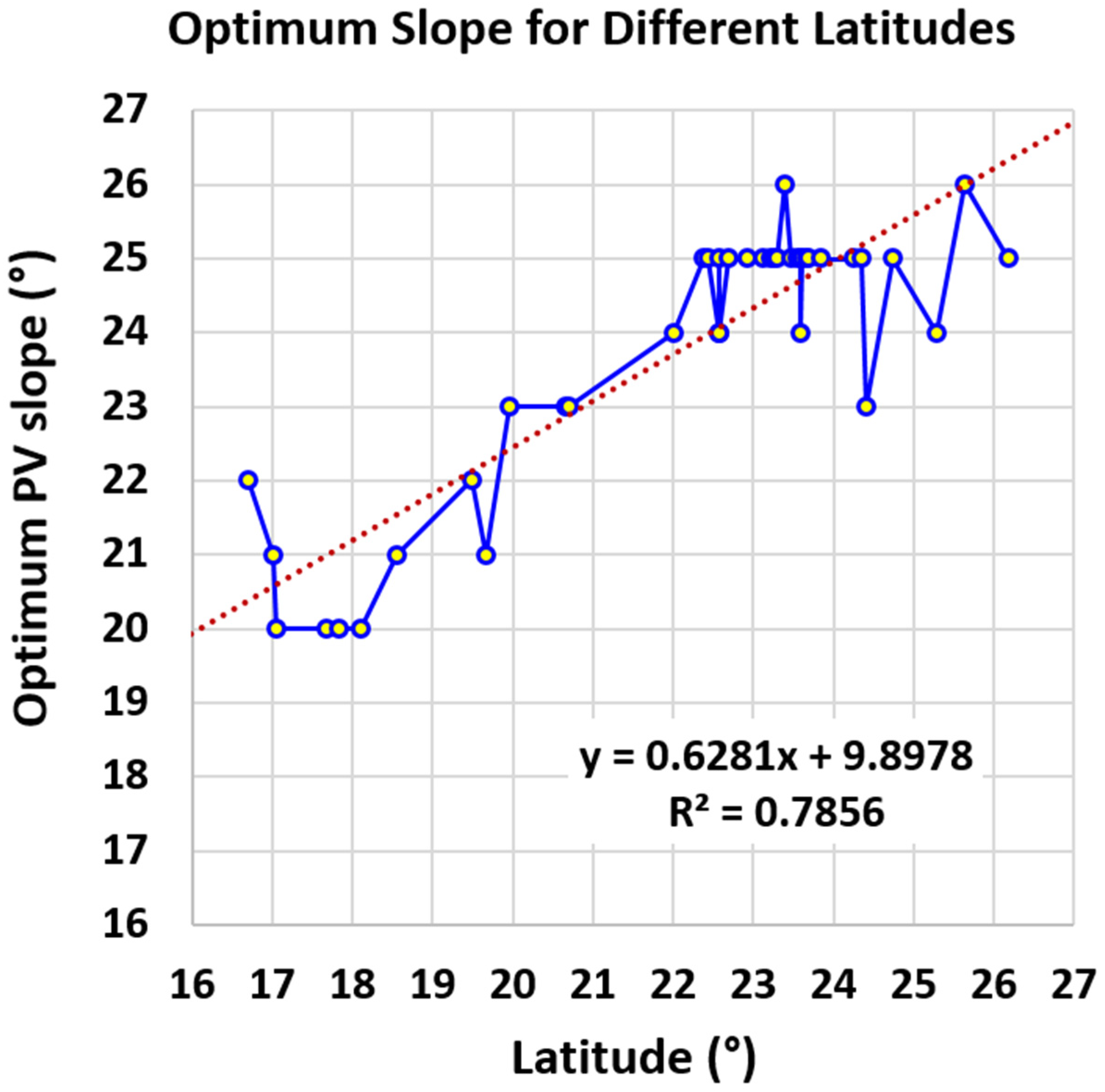
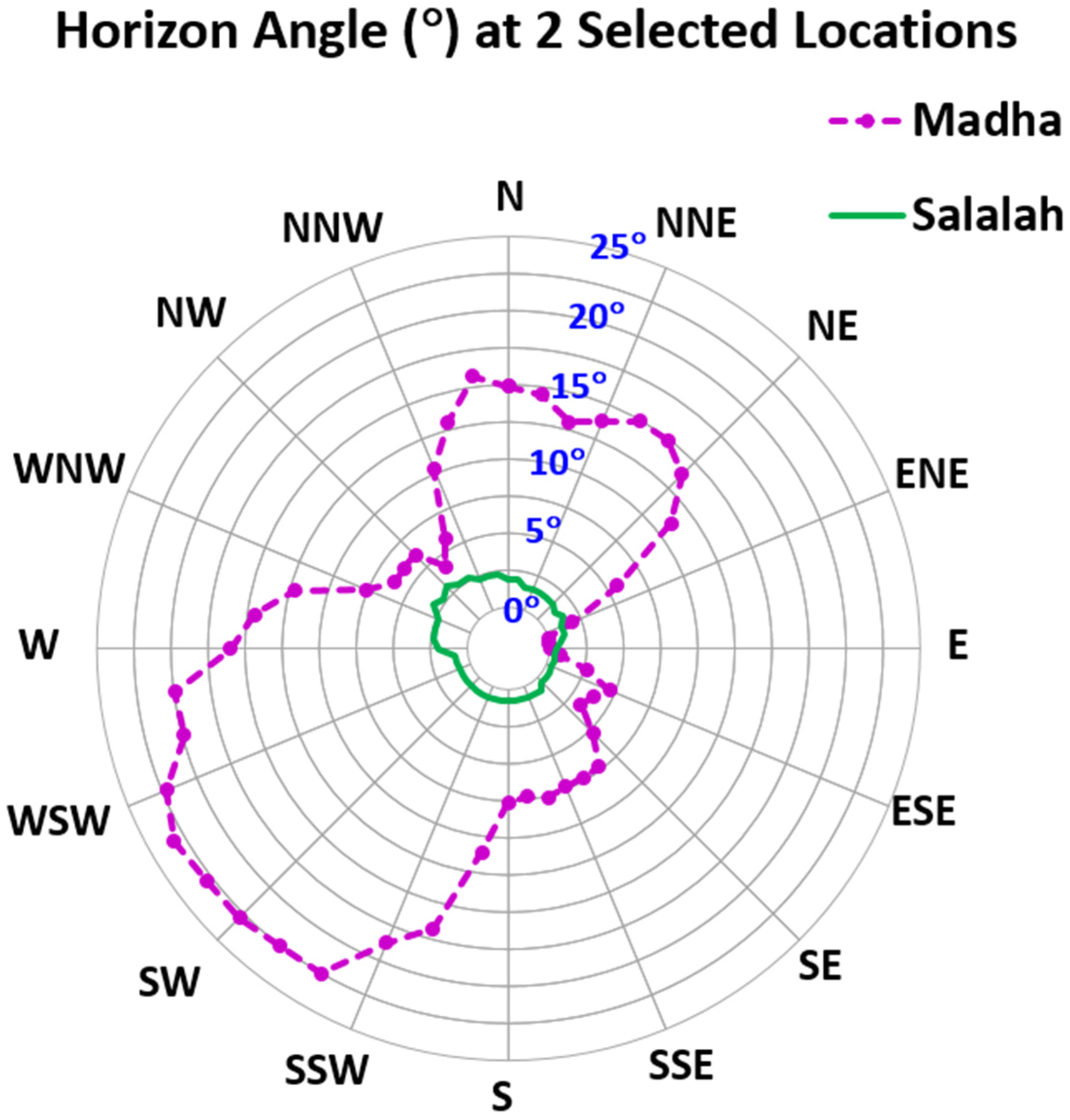
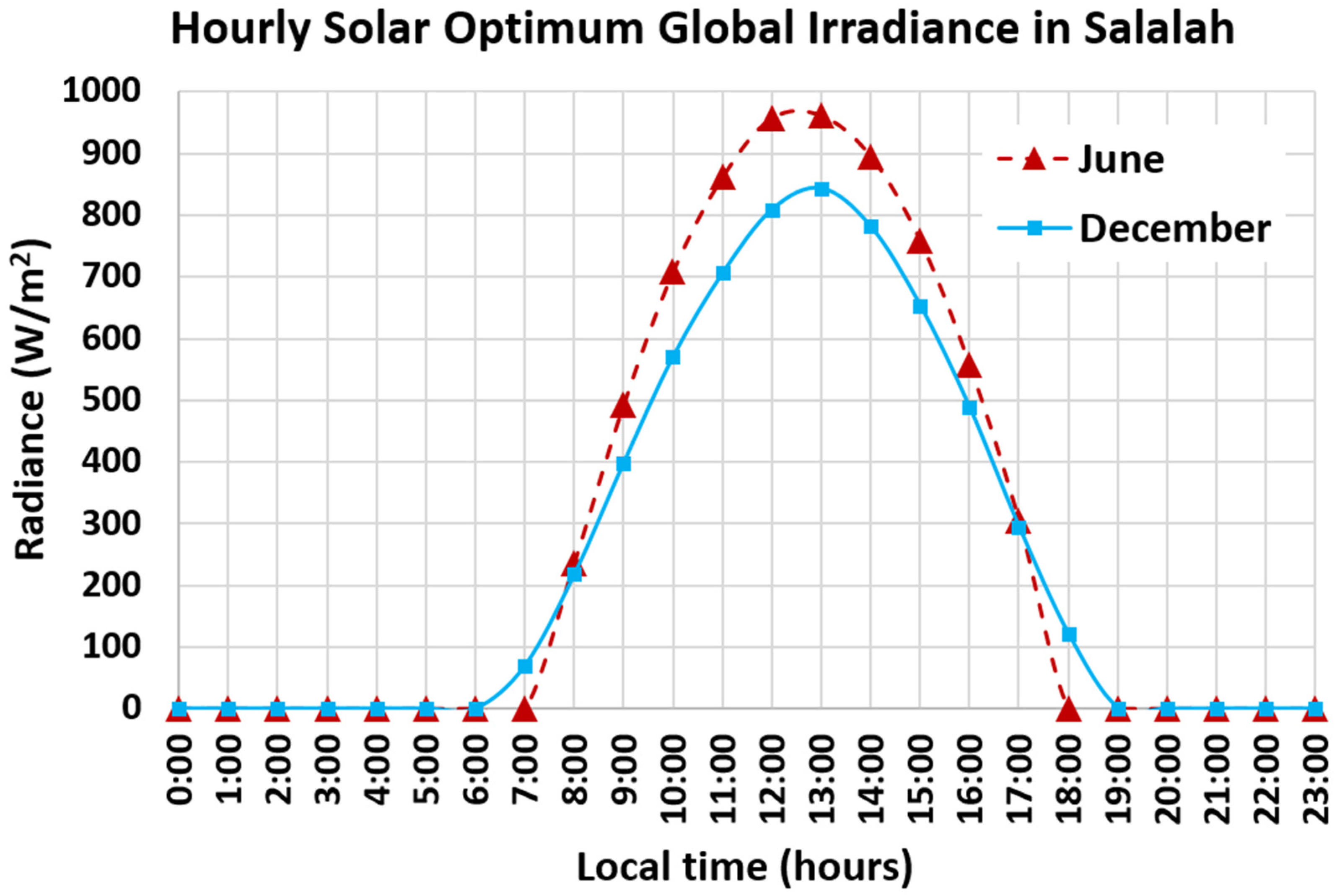

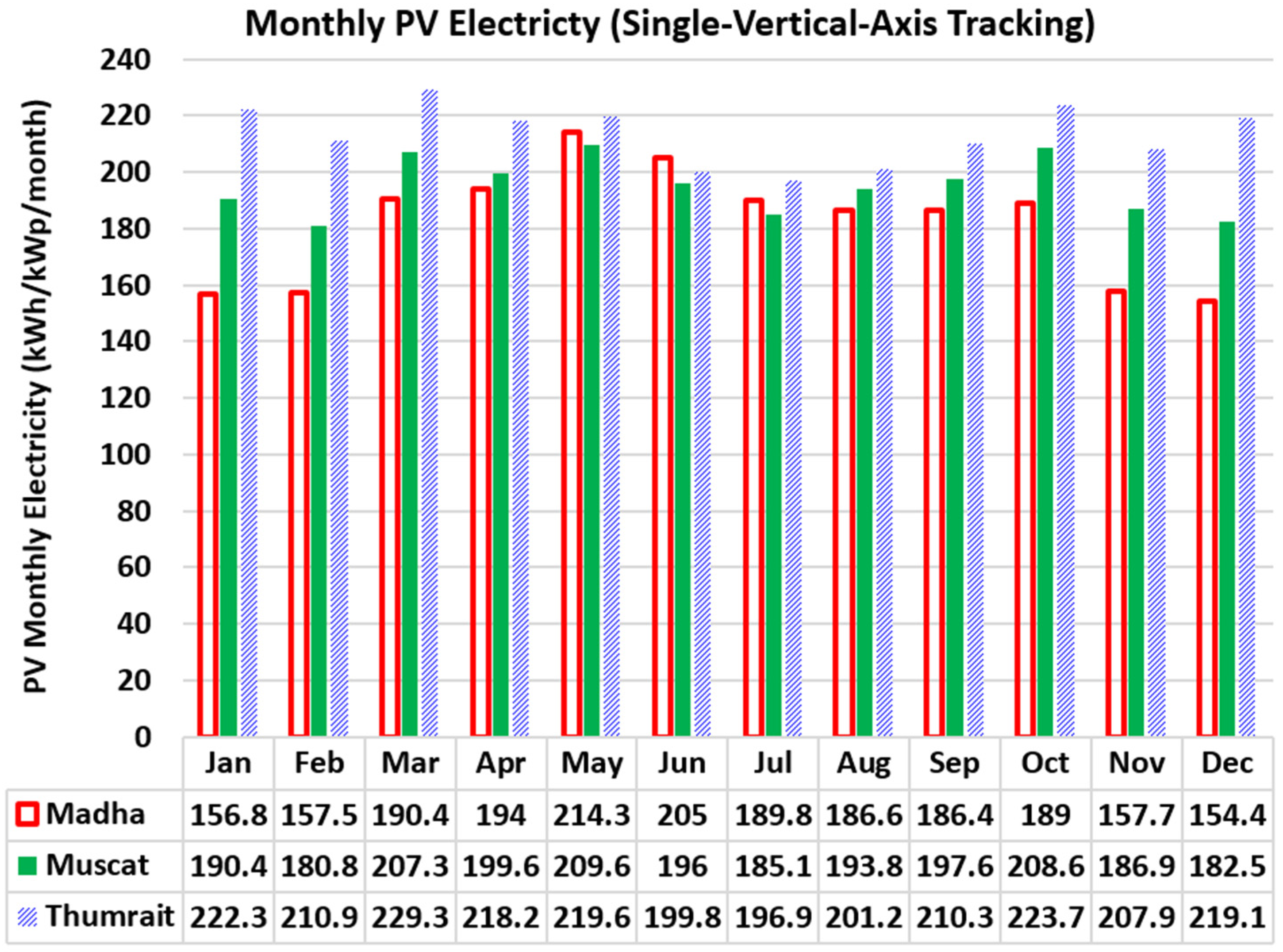

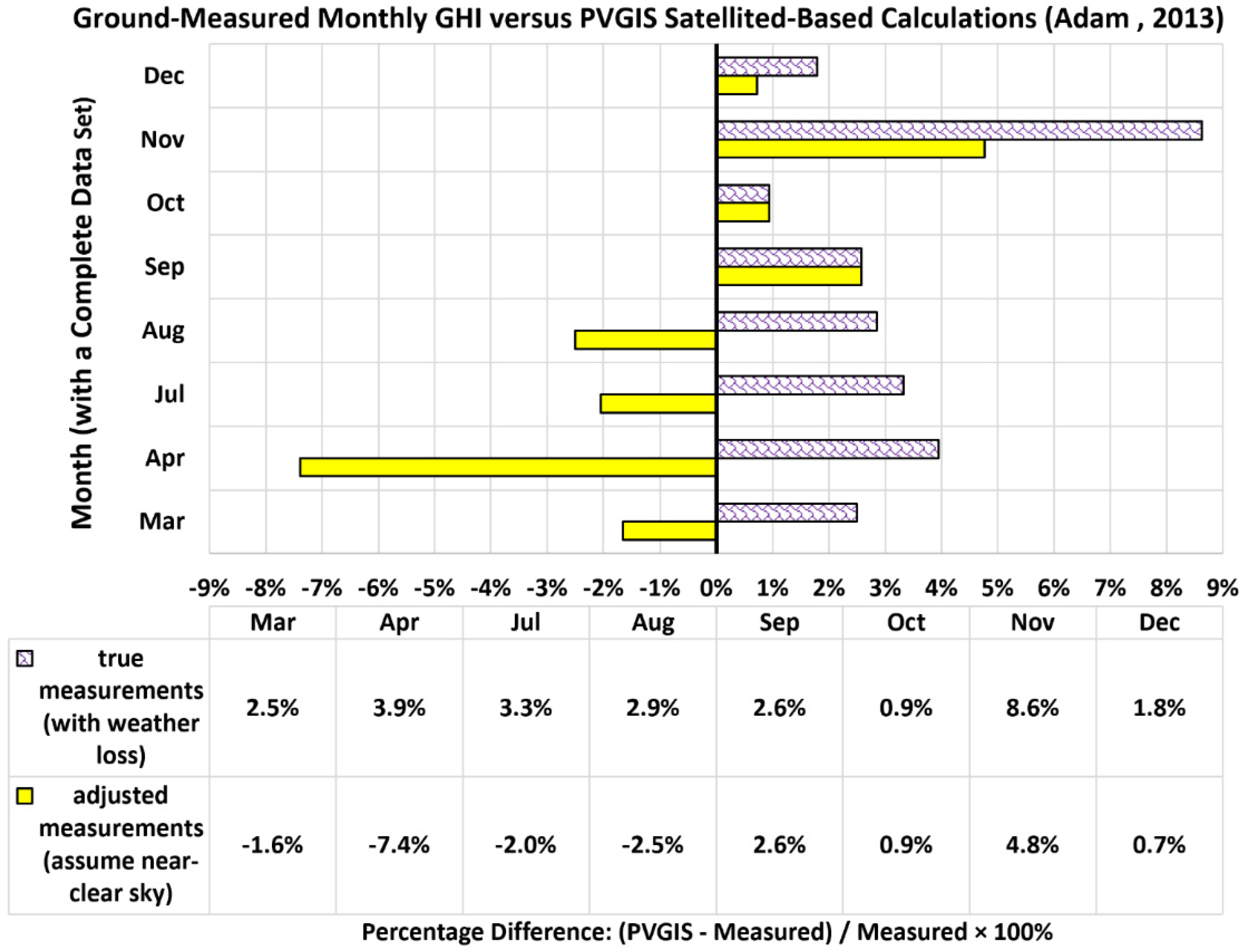
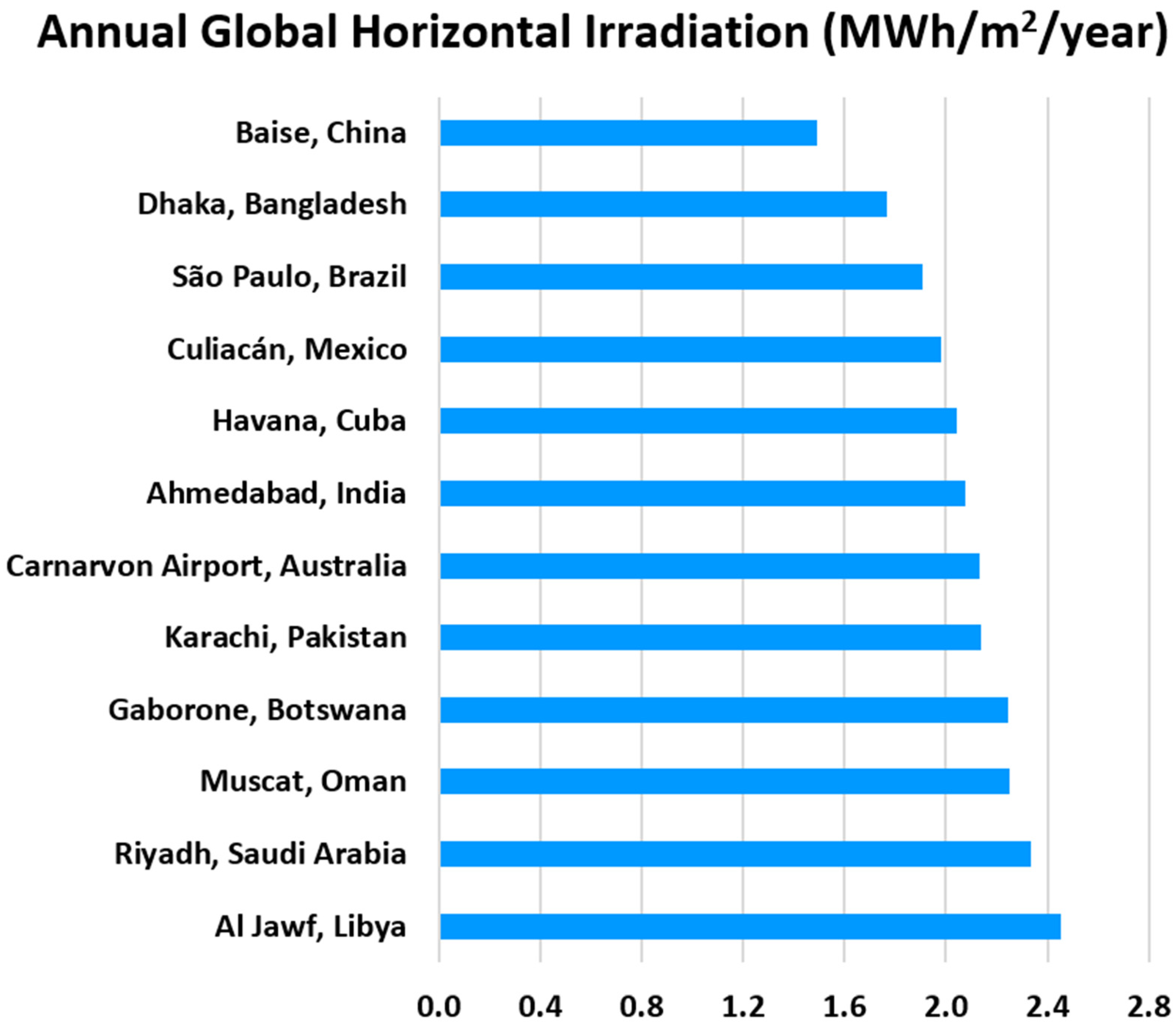

| Index of Selected Wilayats | Governorates (in Descending Order by Population) | Population of the Governorate (as of August 2021) | Number of Wilayats in the Governorate | Number of Selected Wilayats in the Governorate | Selected Wilayats for Analysis (First One is the Administrative Capital of the Governorate) |
|---|---|---|---|---|---|
| 1 | Muscat | 1,270,308 | 6 | 3 | Muscat |
| 2 | Qurayyat | ||||
| 3 | A’Seeb | ||||
| 4 | Al Batinah North | 780,899 | 6 | 3 | Sohar |
| 5 | Al Suwaiq | ||||
| 6 | Shinas | ||||
| 7 | Ad Dakhliya | 478,229 | 8 | 4 | Nizwa |
| 8 | Adam | ||||
| 9 | Samail | ||||
| 10 | Al Hamra | ||||
| 11 | Al Batinah South | 465,210 | 6 | 3 | Al Rustaq |
| 12 | Barka | ||||
| 13 | Wadi Al Ma’awil | ||||
| 14 | Dhofar | 409,019 | 10 | 7 | Salalah |
| 15 | Muqshin | ||||
| 16 | Shalim and the Hallaniyat Islands | ||||
| 17 | Dhalkut | ||||
| 18 | Al Mazyona | ||||
| 19 | Thumrait | ||||
| 20 | Sadah | ||||
| 21 | Ash Sharqiyah South | 314,204 | 5 | 3 | Sur |
| 22 | Masirah | ||||
| 23 | Jaalan Bani Bu Ali | ||||
| 24 | Ash Sharqiya North | 270,520 | 6 | 4 | Ibra |
| 25 | Al Mudhaibi | ||||
| 26 | Wadi Bani Khalid | ||||
| 27 | Bidiya | ||||
| 28 | Adh Dhahirah | 212,954 | 3 | 3 | Ibri |
| 29 | Yankul | ||||
| 30 | Dhank | ||||
| 31 | Al Buraimi | 120,295 | 3 | 3 | Al Buraimi |
| 32 | Al Sunaynah | ||||
| 33 | Mahdah | ||||
| 34 | Al Wusta | 51,191 | 4 | 4 | Haima |
| 35 | Duqm | ||||
| 36 | Al Jazer | ||||
| 37 | Mahout | ||||
| 38 | Musandam | 48,834 | 4 | 3 | Khasab |
| 39 | Dibba | ||||
| 40 | Madha | ||||
| Total | - | 4,421,663 | 61 | 40 | - |
| Characteristic | PVGIS Value | GSA Value | Absolute Difference |
|---|---|---|---|
| Optimum slope (°) | 25 | 26 | 1 |
| Optimum azimuth, from south (°) | 0 | 0 | 0 |
| Yearly PV electricity production per kWp installed (kWh/kWp/year) | 1809.4 | 1819.6 | 10.2 |
| Yearly global solar radiation received by m2 of tilted PV panel surface (kWh/m2/year) | 2500.8 | 2377.5 | 123.3 |
Publisher’s Note: MDPI stays neutral with regard to jurisdictional claims in published maps and institutional affiliations. |
© 2021 by the author. Licensee MDPI, Basel, Switzerland. This article is an open access article distributed under the terms and conditions of the Creative Commons Attribution (CC BY) license (https://creativecommons.org/licenses/by/4.0/).
Share and Cite
Marzouk, O.A. Lookup Tables for Power Generation Performance of Photovoltaic Systems Covering 40 Geographic Locations (Wilayats) in the Sultanate of Oman, with and without Solar Tracking, and General Perspectives about Solar Irradiation. Sustainability 2021, 13, 13209. https://doi.org/10.3390/su132313209
Marzouk OA. Lookup Tables for Power Generation Performance of Photovoltaic Systems Covering 40 Geographic Locations (Wilayats) in the Sultanate of Oman, with and without Solar Tracking, and General Perspectives about Solar Irradiation. Sustainability. 2021; 13(23):13209. https://doi.org/10.3390/su132313209
Chicago/Turabian StyleMarzouk, Osama A. 2021. "Lookup Tables for Power Generation Performance of Photovoltaic Systems Covering 40 Geographic Locations (Wilayats) in the Sultanate of Oman, with and without Solar Tracking, and General Perspectives about Solar Irradiation" Sustainability 13, no. 23: 13209. https://doi.org/10.3390/su132313209





